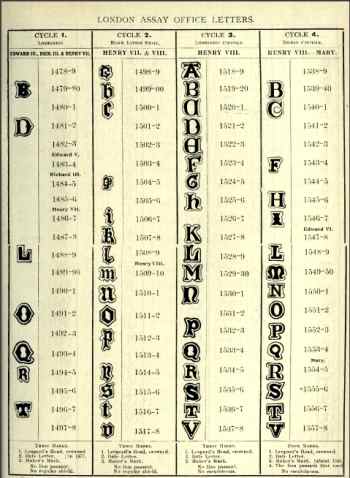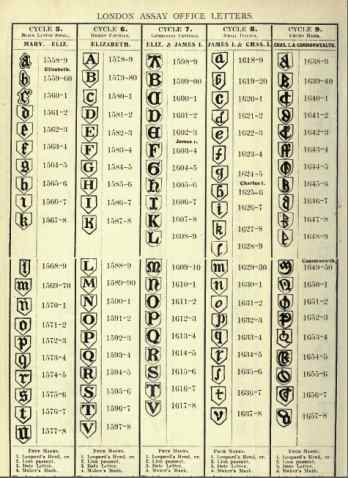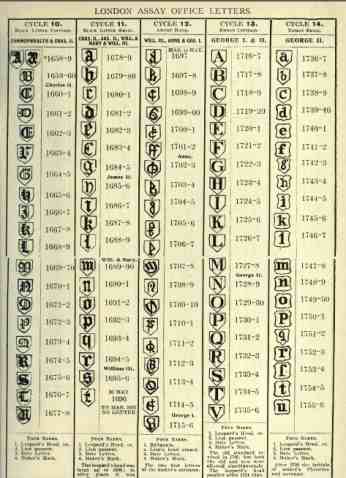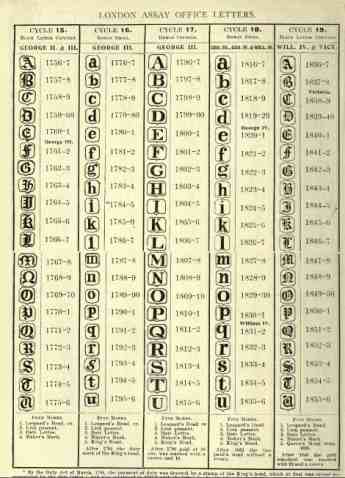(click on photos to enlarge image)
THE DATE LETTER ON ENGLISH HALLMARKED SILVER
A date letter first appeared on English silver plate in the
year 1697 as a result of legislation. In clause VIII of the Act
8 & 9 William III c.8 which, among other things, deals with the
marks that must be applied to assayed plate at Goldsmiths' Hall
the following wording is used: " .... and a distinct variable
mark to be used by the warden of the said
mystery
(see note 1), to denote
the year in which such plate is made;..." This legislation
remained in place until 1999 in which year the Government
adopted European hallmarking practice which does not require
that an assayed item of plate must be dated
(see note 1a).
A similar system of alphabetical lettering had been used on
English assayed plate since 1478 but that this system of
lettering gave some date reference to the piece on which it
appeared was purely coincidental. In 1423 by the statute 2 Henry
VI. c. 13 "The Keeper of The Touch" or "Touch Warden", who was
responsible for striking the leopard's head on all plate assayed
and found to be of the required standard, became liable to a
fine if an article so marked and found to be sub-standard,
should come to light. This statute was reinforced by the statute
17 Edward IV. c. 1. which came into force on 16th. January 1478
and although "The Keeper of The Touch" was again mentioned as
the responsible warden this time the other wardens were
mentioned as well; ".......then for non-sufficiency of the said
Keeper and Worker, the persons of the said craft of goldsmiths
of the said city of London, by whatsoever name or names they be
corporate, shall be chargeable and charged of the forfeitures by
like action or actions of debt as is aforesaid in like manner
and form as immediately before is specified."


|
London Assay Office Letters, as illustrated in
"Hall Marks of Gold and Silver Plate", by William
Chaffers, Tenth Edition, London 1922
|
So that there could be no doubt as to who these wardens
were, in any given year of election during which a particular
item had been assayed, the Goldsmiths' Company decided that an
additional variable mark of identification should be struck on
all assayed wares and the mark chosen was a letter of the
alphabet. It was further decided that every year a punch
engraved with a new letter should come into use on the day of
election of the new wardens and although, initially, this
election took place on St. Dunstan's day, 19th. May, as he is
the patron saint of goldsmiths, this date was not fixed. This
new mark was variously called the "Assayer’s Mark"(see
note 2) or the "Warden’s Mark" and the letters used were
"A" to "U" omitting "J" as this could be too easily confused
with "I".
The Act that gave rise to this additional goldsmiths' mark was
revived in 1487 for a period of 20 years by 4 Hen VII c 23 and
again for another 20 year period in 1553 by 7 Edw VI c 6.
Although no further acts of revival were passed the practice of
striking an alphabetical letter on plate was by then established
and persisted.
It appears that, because the election of wardens took place
annually, this alphabetical letter became accepted as a date
letter although the original intention was to relate it to the
activities of the Goldsmiths' Company and not to the plate on
which it appeared. It is, therefore, a misconception to believe
that there was ever any intention that this new mark should be
used to date the piece which had been assayed. In 1560 it was
referred to as "the letter of the year" and in 1597 as "the
alphabetical mark". More recently it has been treated as if it
were part of an unbroken sequence dating from 1478 to the end of
the 20th century which it most certainly is not as this sequence
was broken in 1697.
Quite obviously it did not represent a calendar year and when
used in this way should, properly, be shown to span two calendar
years.
Although there is a widely held belief that, until the
'Restoration', the re-election of wardens always took place on
19th. May of each year and that after Charles II came to the
throne in 1660 it took place on his birthday which was 29th.
May, this is not the case and, in fact, a range of dates between
May and August can be found until the end of the 17th century.
The 29th May was not regularly used until the beginning of the
18th. century when the statutory date letter had come into use
and even then there were exceptions.(see
note 3) It will be seen that, as the beginning of each
marking year was variable, there are difficulties in using this
letter as a date letter and this may be the reason why the date
on which it was changed became more regularised after it was
introduced by statute
(see note 4).
Until the end of the 17th. century the alphabetical letter was
also used by the Goldsmiths' Company as a means of recording any
change in their affairs by altering it in some way. Thus when,
in 1561 the sterling standard was re-instituted for coin of the
realm following its debasement by King Henry VIII, the
alphabetical letter became enclosed in an escutcheon from 7th.
January of that year because this affected the Goldsmiths'
Company since the new diktat on the sterling standard did not
allow for loss in cupellation.(see
note 5) It was depicted in a changed way again when a
warden was elected mid term because the original appointee had
died or retired as is exemplified in the year 1567/8 in which
the letter "k" was used both unembellished and with a pellet
below because Richard Rogers was obliged to retire and his place
was taken by Thomas Keeling.(see
note 6) The letter "G" for 1664/5 also appears in two
forms for a similar reason. Variations will also be seen in the
years 1544/5, 1619/20, 1627/28 and 1638/39.
A mystery change in
thinking appears to have taken place in 1697, the year in which
the new sterling standard, now known as the Britannia standard,
was introduced. The letter identifying the wardens in office
from 29th. May 1696 was the letter "t" and, instead of merely
altering it in some way, when the new standard came into force
on 25th. March 1697, in accordance with previous practice, a
completely new alphabetical sequence was introduced so that from
27th. March 1697, i.e. before the marking year had ended, until
the 28th May of that year, the letter "a" came into use. For
some time it was believed that, not only had the letter "u" been
omitted, but that the new sequence started with the letter "b"
for 1697/8. It is now known however that there are pieces
stamped with the letter "a" and as this letter was only in use
for two months such pieces are quite rare.
It should be noted that, although the 1697 Act came into force
on 25th. March the new letter was not used until 27th so that
for two days there was no marking. This was because the 25th and
26th March on the Julian calendar in use in England at the
beginning of the 18th century were Saturday and Sunday when the
assay office was not open for business.
A puzzle does however still remain and this concerns the use of
the old letter "t" in conjunction with the new Britannia marks.
On page 151 of the original publication of "English Goldsmiths
And Their Marks" by Sir Charles Jackson the author draws
attention to a spoon made by Lawrence Coles, that must be dated
1697, which is struck with the lower case letter "t" together
with the Britannia marks. This spoon is also struck with Coles'
new Britannia maker's mark. Since the practice in the
Goldsmiths' Company was to "break" the punches after the year of
their use it is difficult to know how this anomaly could have
happened and my initial thought was that the old sequence "t"
must have been used while the new letter "a" was being engraved
but this theory is not borne out by the records at Goldsmiths'
Hall since the new punches were apparently all received together
on 27th March. The minute book for that date reads: "....the
puncheons for the remaining year were received (according to an
Act of Parliament) a lyons head erased, a Britannia and for the
letter a great Court A in an Escutcheon."(see
note 7)
My only thought is that the reason for this anomaly is probably
that the ceremony at which the punches were broken always took
place at the end of the marking year. This being the case the
punch for the letter "t" would have still been in the assay
office until 28th May and therefore available to be used in
error!
This introduction of a completely new sequence of lettering in
1697 gave rise to a misunderstanding when, in 1756, a
determination was made concerning the form that the new
sequence, which started in that year, should take as is shown by
the following entry in the Court of Assistants minute book:
".......about the year 1656 begun the alphabet of the Great Old
English or Old Print taking the first 20 letters and about 1676
the Little Old English or Old Print in like manner and about
1696 the Great Court Hand the like and in 1716 the Great Roman
the like and in 1736 the Little Roman the like so that they
varied the letter every year until 100 were elapsed; wherefore
the Court resolved that the letter for the year ensuing be the
letter A in the alphabet of Great Old English or Old Print and
that the two middle sizes only be first used and the escutcheon
be a lozenge or other escutcheon differing in shape from the
present."(see
note 8)
It seems from this that the Court was unaware of the decisions
taken by its predecessors some half a century earlier and the
resultant interruption in the alphabetical letter sequence. The
first two of the dates quoted in this minute are quite wrong and
they arrived at the date 1696 merely by counting back from 1756
and applying the knowledge that the letter "b" had been used for
the marking year 1697/8.


|
London Assay Office Letters, as illustrated in
"Hall Marks of Gold and Silver Plate", by William
Chaffers, Tenth Edition, London 1922
|
In 1697, when the new sterling standard (Britannia standard)
was introduced, the alphabetical letter was given legal status
for the first time and by that date had been accepted, by those
responsible for the legislation, as nothing other than a date
letter as is shown by the wording of the Act as shown above.
Since this letter had become accepted as a date letter at this
time it is strange that the opportunity was not taken to relate
it to the calendar year. Indeed it is even more strange that it
continued to represent a period of twelve months which bridged
two calendar years into the late 20th century.
A possible explanation for the complete departure, by the
Goldsmiths' Company, from previous practice following the
introduction of the 1697 Act could be in the wording of that Act.
The last year in which the alphabetical letter was related
solely to the election of the wardens was 1696 represented by
the letter "t" and I feel that it is possible that had the "distinct
variable mark" not been mentioned in the 1697 Act, the letter
"t" might well have appeared in an altered form to mark the fact
that the standard of fineness for silver had changed. The
wording of the Act, however, specifically related the "distinct
variable mark" to "the year in which such plate is made"(see
note 9) and thus divorced it from the election of the
wardens. It was therefore a new statutory mark which happened,
by coincidence, to be similar to that previously used by the
Goldsmiths' Company for their own purposes.
The Goldsmiths' Company may well have considered it desirable to
make a clean break with the old system in order to show that the
new had no connection with the election of its wardens and if
this were the case the use of a completely new sequence of
letters is easily explained. Apart from changes in the shield
outline no embellishment has been used with the "date letter"
since its inception in 1697 when it became a date letter and not
related to the Company or its Wardens.
It is interesting to note that both Chester and York, the only
two provincial offices which used recognisable alphabetical
sequences before 1697, also broke off the letter sequences they
were using and started new ones in 1701, as soon as they were
covered by statute.
ACKNOWLEDGEMENT
I am grateful to the Worshipful Company of Goldsmiths for
extending to me the privilege of examining their records.
David McKinley
- 2013 -
David McKinley devotes much of his time to
researching the history of silversmithing in England
with particular reference to hallmarking at the London
office. He writes for both The Silver Spoon Club of
Great Britain and The Silver Society.
David McKinley is the author of the book THE FIRST
HUGUENOT SILVERSMITHS OF LONDON
Information about the content of this book and the
discounted price applied to members of ASCAS is
available in
September 2011 Newsletter
|
|




